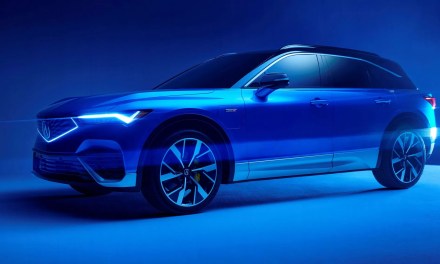Among the new technologies and collaborative projects BlackBerry unveiled at CES 2024, one was a significant new vehicle interior technology suite involving Stellantis and AWS (Amazon Web Services). Stellantis led the creation of what is said to be the world’s first virtual cockpit platform as part of its Virtual Engineering Workbench (VEW), which enables the delivery of infotainment tech to customers 100 times faster than previous processes, according to the automaker.
The new platform uses the QNX Hypervisor in the cloud from BlackBerry, which is now on early access release via AWS Marketplace within the QNX Accelerate portfolio of cloud-based tools.
Stellantis says it can now create realistic virtual versions of car controls and systems, making them behave just like they would in a real car but without needing to change the main software that runs them, reducing development time from several months down to 24 h in some cases. Accessing QNX Hypervisor via AWS Marketplace enables Stellantis to include a virtual cockpit HPC (high-performance computing) simulation in a cloud environment.
This industry-first platform for mixed-criticality and multi-OS embedded application development includes QNX Hypervisor AMIs (Amazon Machine Images) and industry-standard hardware interfaces defined in the VirtIO standard Trout v1.2. With tools such as virtualization of graphics, audio, and touchscreen/mouse/keyboard inputs, the solution offers little to no difference between running QNX Hypervisor-based systems in the cloud versus on real hardware.
Stellantis says that software is a key building block for the automaker to deliver clean, safe, and affordable mobility, as outlined in its Dare Forward 2030 strategic plan, and the driving force behind the AI-powered STLA Brain, STLA SmartCockpit, and STLA AutoDrive technology platforms. In 2022, Stellantis selected AWS as its preferred cloud provider for vehicle platforms and the companies began work on VEW.
The automaker has been using CES to show what could be possible with its future vehicles including their interiors. At CES 2023, it showed a Chrysler Synthesis demonstrator, providing a forward-looking glimpse into the brand’s future and previewing the first application of new corporate technologies in North America. The technology-forward and sustainable interior design was aimed at a mobility experience that is more user-friendly, more connected, and more efficient.
“Software is becoming increasingly crucial in vehicles, leading us to innovate in how we develop and validate it,” said Yves Bonnefont, Chief Software Officer at Stellantis. “With our virtual cockpit, we’re revolutionizing not just our approach but also that of our suppliers and partners in the industry. Essentially, we’re able to get closer to our customers’ needs through this technology with faster development cycles, faster feedback loops, and quicker delivery of the technology they use and love. It’s a leap towards customer-first innovation and efficiency in the automotive world.”
Taking a software-driven approach and deploying the QNX Hypervisor in the cloud, Stellantis can accelerate customer feedback sessions and, with minimal effort, replicate the cockpit experience of a particular brand and vehicle and make changes in real-time to optimize the experience for the driver. This real-time feedback, underpinned by low-latency access to the cloud, allows Stellantis to solicit valuable feedback from its customer and developer base to build future infotainment features and applications.
“We’re delighted to introduce early access availability of our trusted QNX Hypervisor platform in the cloud, leveraging the vendor and platform-neutral VirtIO standard that QNX has long supported for its importance in creating a true-to-life virtual development environment for embedded software,” said Mattias Eriksson, President, BlackBerry IoT. “Working with Stellantis to launch the world’s first commercial hypervisor in the AWS cloud helps to reduce complexity, accelerate innovation, and cut costs on in-car software development throughout the entire product lifecycle.”
Standard VirtIO interfaces are also used by a suite of automotive partners to scale their offerings across OEMs and enable plug-and-play across the OEM landscape. Recognizing the benefits, AWS fully supports the VirtIO industry standard for cloud simulation of cockpit HPCs.
“Software virtualization and abstraction in the cloud is vital to accelerating development and maintaining feature delivery on pace with consumer demand,” said Wendy Bauer, Vice President and General Manager of Automotive and Manufacturing, AWS. “With BlackBerry’s QNX Hypervisor on AWS Marketplace, Stellantis can easily harness the power of the cloud to reimagine research and development processes, architect more insightful ways to solicit and integrate feedback, and deliver functions faster than before that delight drivers and further the industry.”
BlackBerry QNX launched QNX Accelerate in January 2023 with its portfolio initially featuring QNX Neutrino RTOS 7.1 and the QNX OS for Safety 2.2.3, each provided as Amazon Machine Images allowing QNX customers to run a QNX OS natively on AWS cloud hardware. The early access release of QNX Hypervisor in the cloud is available now and general availability will be announced later in 2024.
A non-branded technology demonstration was available at CES 2024 in the BlackBerry booth.
- Stellantis STLA strategy encompasses hardware, software, and AI.
- The Chrysler Synthesis concept from CES 2023 highlighted the Stellantis STLA SmartCockpit infotainment.
















































































